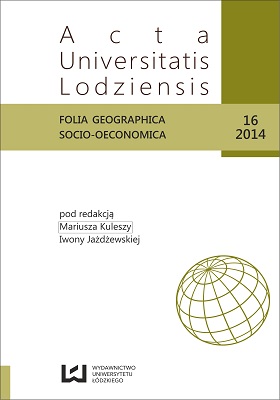Wielkość i kształt działek gruntowych w Łodzi
DOI:
https://doi.org/10.18778/1508-1117.16.09Słowa kluczowe:
działki gruntowe, struktura przestrzenna, przestrzeń wielkomiejska, Łódź, GISAbstrakt
Przedmiotem tego opracowania jest zróżnicowanie przestrzenne wielkości i kształtu działek gruntowych w warunkach wielkomiejskich, rozpatrywane na przykładzie Łodzi. Zagadnienie to poprzedzono charakterystyką rozmieszczenia i gęstości działek. Cel pracy stanowi identyfikacja ukształtowanego w warunkach rynkowych stopnia zróżnicowania struktury przestrzennej działek według ich wielkości i kształtu przy użyciu narzędzi GIS.
Bibliografia
Conzen M.P., 2002, From Alnwick to Cincinnati: Teasdale property cycles in Old World and the New, „Urban Morphology”, 6(1).
Google Scholar
Conzen M.R.G., 1960, Alnwick, Northumberland. A study in town-plan analysis, The Institute of British Geographers, Publication, 27
Google Scholar
DOI: https://doi.org/10.2307/621094
Dzieciuchowicz J., 2011, Środowisko mieszkaniowe wielkiego miasta. Przykład Łodzi, Wydawnictwo UŁ, Łódź.
Google Scholar
Jażdżewska I., 1999, Przemiany funkcjonalne i morfologiczne przestrzeni geograficznej wsi Rzgów w świetle metod numerycznych, ŁTN, Łódź.
Google Scholar
Kopczewska K., 2008, Renta geograficzna a rozwój społeczno-gospodarczy, CeDeWu, Warszawa.
Google Scholar
Kostrubiec B., 1972, Analiza zjawisk koncentracji w sieci osadniczej, „Prace Geograficzne IG PAN”, 93.
Google Scholar
Koter M., 1969, Geneza układu przestrzennego Łodzi przemysłowej, „Prace Geograficzne IG PAN”, 79.
Google Scholar
Koter M., 1974, Fizjonomia, morfologia i morfogeneza miasta. Przegląd rozwoju oraz próba uściślenia pojęć, „Zeszyty Naukowe Uniwersytetu Łódzkiego”, Ser. II, z. 55.
Google Scholar
Koter M., 1979, Struktura morfogenetyczna wielkiego miasta na przykładzie Łodzi, „Acta Universitatis Lodziensis”, Ser. II, z. 21.
Google Scholar
Koter M., 1994, Od fizjonomii do morfogenezy i morfologii porównawczej. Podstawowe zagadnienia teoretyczne morfologii miast, [w:] Koter M., Tkocz J. (red.), Zagadnienia geografii historycznej osadnictwa w Polsce, Materiały konferencyjne, UMK, UŁ, Toruń‒Łódź.
Google Scholar
Kotlicka J., 2008, Przemiany morfologiczne terenów przemysłowych Łodzi, ŁTN, Łódź.
Google Scholar
Liszewski S., 1977, Tereny miejskie a struktura przestrzenna Łodzi, „Acta Universitatis Lodziensis”, UŁ, Łódź
Google Scholar
Liszewski S., 1979, Zróżnicowanie przestrzenne użytkowania ziemi w Łodzi, „Acta Universitatis Lodziensis”, Ser. II, Folia Geographica, 21.
Google Scholar
Liszewski S., 1997, Przemiany funkcjonalne i przestrzenne terenów przemysłowych Łodzi, „Zeszyty Instytutu Geografii i Przestrzennego Zagospodarowania PAN”, 47, Aglomeracje miejskie w procesie transformacji, VI.
Google Scholar
Miszewska B., 1979, Elementy struktury morfologicznej Wrocławia, „Acta Universitatis Wratislaviensis”, 438, Prace Instytutu Geograficznego, ser. B, Geografia Społeczno-Ekonomiczna, t. 3.
Google Scholar
Miszewska B., 1994, Bloki urbanistyczne Wrocławia w różnych fazach cyklu miejskiego, [w:] Koter M., Tkocz J. (red.), Zagadnienia geografii historycznej osadnictwa w Polsce, Materiały konferencyjne, UMK, UŁ, Toruń‒Łódź.
Google Scholar
Miszewska B., 1996, Struktura morfologiczna peryferyjnych osiedli Wrocławia, „Acta Universitatis Wratislaviensis”, 1904, Prace Instytutu Geograficznego, ser. B, Geografia Społeczno-Ekonomiczna, nr XIV.
Google Scholar
Piech M., 2004, Przemiany funkcjonalne terenów przemysłowych w latach 1988‒1996 (w granicach kolei obwodowej), ŁTN, Łódź
Google Scholar
Pobrania
Opublikowane
Jak cytować
Numer
Dział
Licencja

Utwór dostępny jest na licencji Creative Commons Uznanie autorstwa – Użycie niekomercyjne – Bez utworów zależnych 4.0 Międzynarodowe.








